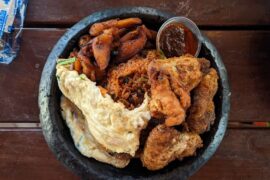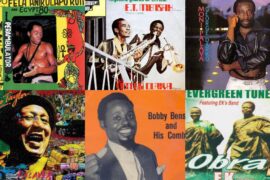What is Kente?
Kente is a popular traditional Ghanaian cloth made using a wooden loom woven by the Asantes and Ewes. Kente is also made on smaller scales in Togo. It isn’t the only cloth made with looms but it is the most popular.How is Kente Made?
One thing that screams out of every kente design and cloth is the attractive colors and beautiful patterns. To achieve such patterns, kente weavers carefully use warps placed horizontally and vertically. They have stretched away from the loom. The process is highly manual. The use of a weft is employed to weave the warp together. The creativity of the weaver is very critical. Through the repetitive insertion of the weft threads using a shuttle with a bobbin inside, the weaver creates the pattern. This process creates a single kente strip of about 6 feet long and a few centimeters wide. To get a full cloth, these strips are sewn together. The same process is employed by both Ewes and Ashantis in weaving the kente designs you see on occasions.Beautiful African Kente Designs For Engagement 2021
In Ghanaian society, wherever people are gathered for traditional engagement, there is kente. These are the best kente designs for engagement in 2021. ,
Brief History of Bonwire Kente Design
Bonwire is the center of Kente weaving in the Ashanti Kingdom. The Chief of the area is titled the “Kentehene” meaning “King/Chief of Kente”. The chief of the area was previously not called the Kentehene. However, one day, two of his constituents made a great discovery which led to a series of events that gave him the title. Legend has it that kente was discovered by two hunters who were on an expedition to retrieve their catch at night. While doing so, they saw the beautiful and elaborate patterns of the spiderweb. They studied it and later had an offer from Ananse (The Spider) to teach them. Ananse would teach them to weave if they could help him with a few favors. They obliged and came back home with the knowledge to weave what would later be called kente. They perfected their first design and showed it to their chief. He was elated and liked the invention well that he took them to show it to the Asantehene. There, the Asantehene would adopt the cloth as Royal Clothing naming it ”Gagamuga”. As time went on, the hunters would develop their skills and come up with a new design. The patterns looked like a woven basket. Out of this likeness, the community began to call the cloth “Kenten-Nwin-Ntoma” which means “woven-basket-cloth” later corrupted as only “Kente”.My Skills are Exhausted “Adwene asa”
The Asantehene once commissioned a weaver to come with the best kente design. After working hard, the weaver came up with a design he called “Adwene asa” which means “the mind is finished” or “I have exhausted my skills”. This is perhaps the most popular kente design out there. The design was displayed at the UN General Assembly in New York City: woven by master kente weaver Kwasi Asare. The cloth was restricted to only royals. This began to change as it gained popular appeal. Families passed it down generations as an heirloom. It was only worn during special occasions such as traditional festivals and ceremonies.Brief History of Ewe Kente Design
History has it that the Ewe people made migrations before settling in Ghana. They interacted with people from Togo and other places. Through these travels, they created the kente weaving process. However, Ewes from the northern parts of the Volta region town of Kpetoe claim to be of Asanti origins. Ewe weavers of kente are mainly found in Kpetoe and Agbozume. It is possible that they created the kente weaving process. This is because of the availability of the materials used to weave kente. These are plain silk, rayon, or cotton. Unlike the Asanti area, the Ewe area abounds with these materials. Also, the northern parts of Ghana widely weave their own “Kente” in similar ways using the same materials. The origins are likely to be from those areas where the materials abound. Ewe kente design has a history that isn’t is very clear. However, Ewes have been influenced by neighboring Togo, Benin, and even Nigeria. As to who learned to weave kente from who isnt very clear. Ewe kente has a varied style and design that reflects the influence from the various sources.Differences and Similarities Between Bonwire and Ewe Kente Design
Similarities Between Ewe and Bonwire Kente Design.
The looms used in weaving both Ewe and Bonwire Kente are very similar to the extent that we could agree that they have the same or similar origins. The designs of both ethnic groups on the surface may look the same. This tendency is heightened by modern trends where Ewes weave for demand. Ewes do not necessarily weave what traditionally was woven. Even though the histories may not be clear, the differences and similarities are quite clear. The looms used by both Ewes and Bonwire are similar. Also, the use of bright colors can be agreed on.Dr. Osei Kwame Despite’s Wealth Revealed: How Much Money Does He Have?
Take a deep dive into the financial empire of Dr. Osei Kwame Despite, where his staggering wealth and its mysterious origins will leave you wanting more.
Differences Between Bonwire and Ewe Kente Design.
The primary differences lie in the use of patterns and color. Ewe kente designs use different colored strips of kente which are sewn together to create the cloth. Also, Ewe kente makes use of pictorial representatives as well as text. It’s common to see images of people and household items in Ewe designs. Through pictures and patterns, Ewes create meaning. Ewe kente styles traditionally used less bright colors. You could see the same colors in Ewe kente used in Bonwire designs but different shades where the Ewe colors were dull and less striking. Bonwire kente designs have an abstract pattern. Meaning is often imposed on the design using either the name of the weaver, the name of the person who commissioned it, a proverb, etc. The differences are based on the designs they traditionally made. In modern times, Ewes and Ashantis weave almost the same designs. This is because of the demand for “Modern” designs.Bonwire and Ewe Kente Styles; Which is the Best?
Really, there is no telling. Both use creative patterns, powerful meaning, and significance, and attractive colors. Both Ewe and Bonwire kente are great for special occasions.Conclusion
Both Bonwire and Ewe kente design have a history. This is probably the reason for their striking similarity. However, the more representational nature of the Ewe kente styles compared to the abstract Bonwire kente styles make for all the differences between them. Which do you like? Which do you think is the best?Discover more from Ghana Scoop
Subscribe to get the latest posts sent to your email.





